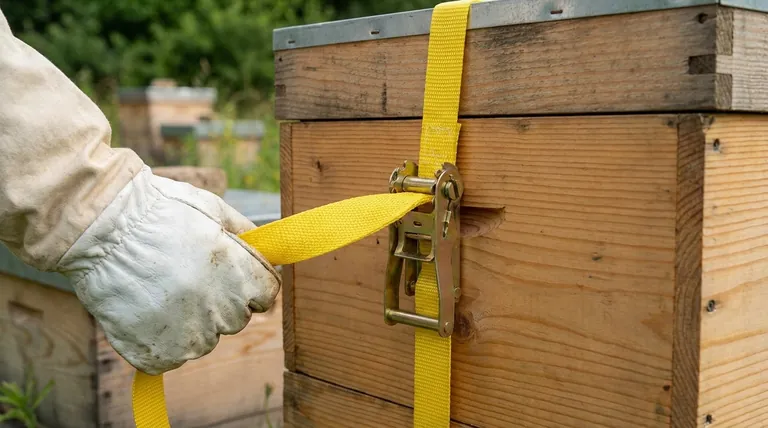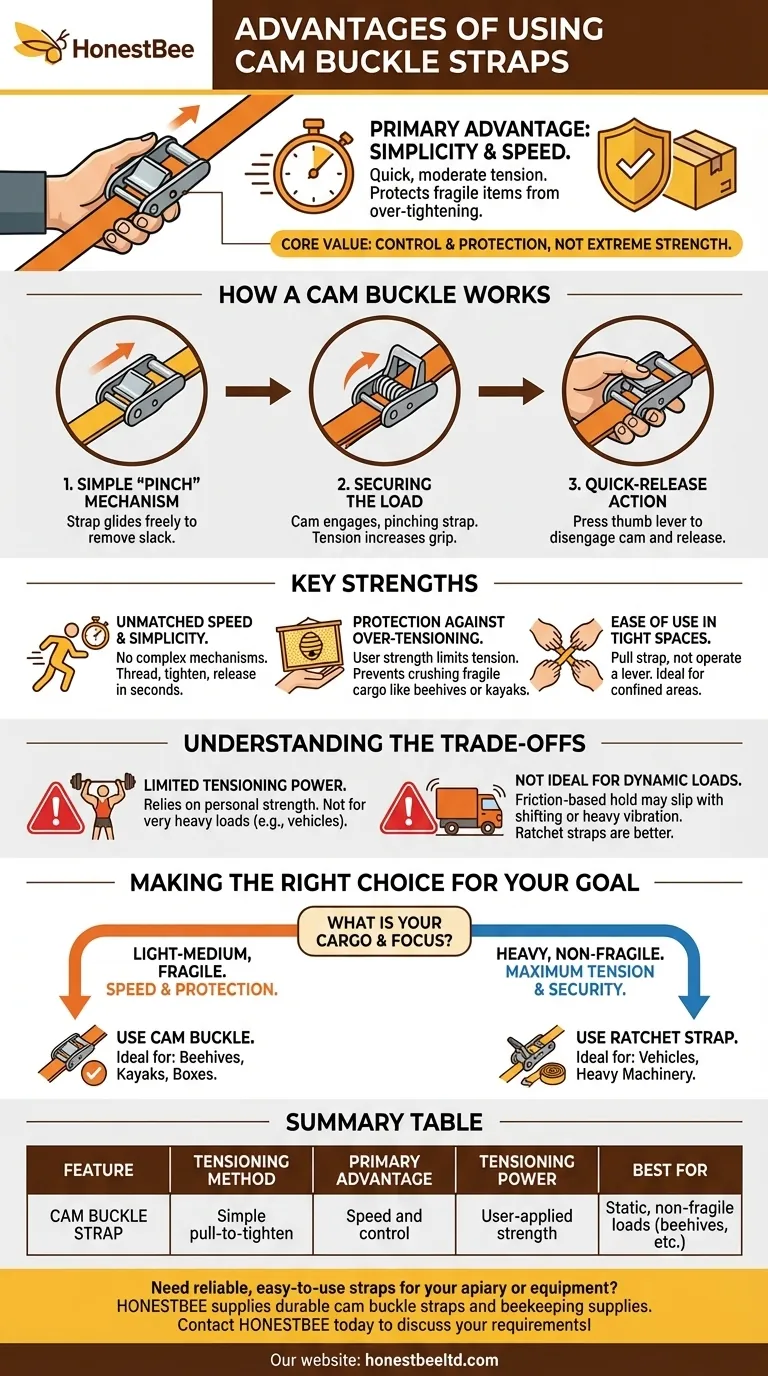The primary advantage of using a cam buckle strap is its combination of simplicity and speed. Unlike more complex mechanisms, a cam buckle allows you to secure an object quickly by simply threading the strap and pulling it tight. This design is ideal for applications where moderate tension is sufficient and you need to avoid the risk of damage from over-tightening.
The core value of a cam buckle is not its strength, but its control. It provides fast, secure fastening for loads where user-applied tension is all that's needed, protecting fragile items from the crushing force of more powerful tie-downs.

How a Cam Buckle Works
The Simple "Pinch" Mechanism
A cam buckle operates on a straightforward principle of friction and leverage. The buckle contains a spring-loaded, toothed or textured "cam" component.
When you pull the loose end of the webbing, the strap glides freely through the buckle, allowing you to remove slack and apply tension.
Securing the Load
Once you stop pulling, the cam's spring engages, causing it to pivot and pinch the webbing tightly against the buckle's frame. The tension from the strap itself increases this pinching force, effectively locking it in place.
The Quick-Release Action
To release the tension, you simply press down on the buckle's thumb lever. This action disengages the cam, instantly freeing the webbing and allowing the strap to be loosened or removed.
Key Strengths of the Cam Buckle
Unmatched Speed and Simplicity
The core operational advantage is its efficiency. There is no complex ratcheting, winding, or spooling required. You thread the strap once and can then tighten and release it in seconds.
Protection Against Over-Tensioning
A cam buckle's tension is limited by how hard you can physically pull the webbing. This is a critical safety feature when securing fragile or crushable items, such as a kayak, a stack of boxes, or beehive components.
Ease of Use in Tight Spaces
Because you are just pulling a strap rather than operating a lever, cam buckles are often easier to use in confined areas where the range of motion for a ratchet handle would be restricted.
Understanding the Trade-offs
Limited Tensioning Power
The most significant limitation of a cam buckle is its reliance on your personal strength. It cannot generate the extreme tension necessary for securing very heavy loads, like a vehicle on a trailer. The holding force is significantly lower than that of a ratchet strap.
Not Ideal for Dynamic Loads
For loads that may shift, settle, or vibrate heavily during transport, the friction-based hold of a cam buckle could potentially slip over time. A mechanism with a positive lock, like a ratchet strap, is better suited for such "dynamic" loads.
Making the Right Choice for Your Goal
The decision between a cam buckle and other tie-downs depends entirely on the nature of your load.
- If your primary focus is securing light to medium-weight, fragile items quickly: A cam buckle is the ideal tool, as it protects your cargo from damage and is incredibly efficient.
- If your primary focus is securing heavy, non-fragile cargo for transport: You must use a high-tension system like a ratchet strap to ensure the load is properly and safely immobilized.
Choosing the correct tool ensures both the safety of your cargo and the efficiency of your work.
Summary Table:
| Feature | Cam Buckle Strap | Ideal Use Case |
|---|---|---|
| Tensioning Method | Simple pull-to-tighten | Fast, moderate tensioning |
| Primary Advantage | Speed and control | Protecting fragile items |
| Tensioning Power | User-applied strength | Light to medium loads |
| Best For | Static, non-fragile loads | Securing beehives, kayaks, boxes |
Need reliable, easy-to-use straps for your apiary or equipment? HONESTBEE supplies durable cam buckle straps and other essential beekeeping supplies to commercial apiaries and distributors. Our wholesale-focused operations ensure you get the quality equipment you need to secure your valuable assets efficiently and safely. Contact HONESTBEE today to discuss your requirements!
Visual Guide

Related Products
- Professional Galvanized Hive Strap with Secure Locking Buckle for Beekeeping
- HONESTBEE Professional Hive Top Bee Feeder Feeding Solution
- Black Plastic Beetle Barn Hive Beetle Trap for Beehives
- Reusable Clear Small Hive Beetle Traps for Beehives Beetle Trapping Tools
- Professional Hive Top Bee Feeder for Beekeeping
People Also Ask
- Can straps with hook ends be used for beehives? A Guide to Secure Hive Management
- How should a cam buckle strap be installed for optimal performance? Master the Leverage for Maximum Tension
- What are the types of Emlocks available? Choose the Right Strap for Hive Security
- Why are hive straps important for beekeepers? Secure Your Hives Against Wind, Predators & Transport
- What is the best length for straps used around beehives? Why 12 Feet is the Industry Standard



















